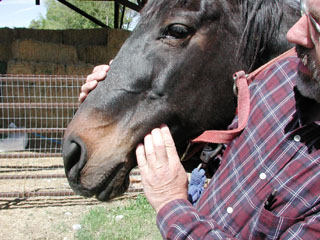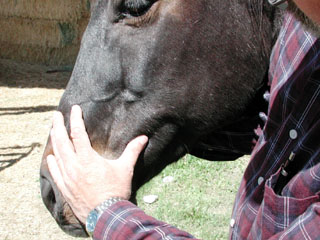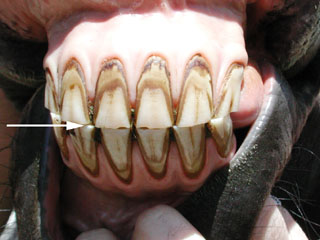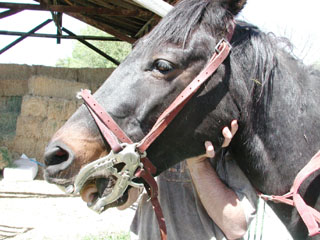To adequately understand
equine dentistry, a basic oral (mouth) anatomy and functionality lesson is
required. A horse’s teeth continue to grow throughout its life. This could
pose a serious problem if most parts of the teeth did not wear down (about
one-eighth of an inch per year) with the horse’s powerful chewing action.
However, because the upper jaw is wider than the bottom jaw, all parts of the
horse’s pre-molar and molar teeth do not wear evenly. Because of the uneven
wear, very sharp points can be found on the outside edge of the upper teeth and
the inside edge of the lower teeth.
A horse’s cheeks and tongue are very vulnerable to damage from the points
on the inside and outside of the teeth. As the horse chews in an almost rotary
type motion, the tongue and cheeks are often forced to contact the sharp points.
When these structures are injured, great pain and soft tissue damage can result.
A horse’s tongue is often so large that it is almost impossible for the horse
to avoid the sharp points. Many horses often experience significant pain when
they are forced to flex the head downward. This position can force an already
crowded tongue and soft tissues into the sharp points of the teeth.
Identifying Dental Problems: Many horses do not show outward signs of
pain, even with significant injury to the tongue and cheeks. Other horses may be
in good condition and yet still have teeth problems. Because of this, the
following suggestions are a must to help every horse owner identify a potential
dental problem in a horse.
- The first step in determining if a horse needs dental work is to simply
stand back and observe the animal. Thin horses often have dental problems
that prevent them from properly grinding and even consuming their feed.
Watch the horse eat. Look for any abnormalities in the way the horse chews
its feed. Horses that have problems will often drop feed (particularly
grain) out of their mouths (see figure #1), stick their heads out, and twist
their heads from side to side. They may eat slower and act like they are
chewing delicately. Horses with problems may also salivate excessively.
Certain feeds, like whole-grains and long stemmed hays, are often harder for
a horse to chew. If a horse eats all the soft pellets, but leaves the hay,
dental problems should be evaluated.
- A horse that colics frequently because of impactions can be doing so
because of teeth problems. The reason for this is two-fold. First, the horse
with bad teeth cannot grind and break-up feed material well because of pain
or poor grinding surfaces. Secondly, as a horse drinks the saliva that is a
natural mouth protectant is washed way, causing the horse more pain when it
eats. This makes the horse less prone to drink and can cause mild
dehydration. Ingesting longer feed fibers coupled with slight dehydration
increases the horse’s chances of having an impaction.
- Examine the horse’s manure for evidence of long pieces of hay that do
not appear to be ground up properly. Also look for evidence of whole grains
that pass untouched by the teeth through the digestive tract. Both of these
are indications that the horse has a dental problem.
- Observe the horse while a bit is in the mouth. Horses with teeth problems
will often resist having the bit put into the mouth. Once it is in the
mouth, the horse may chew on the bit excessively, turn and jerk its head
sideways, and resist any flexing motions. Try working the horse without a
bit in place. If the problems seem to subside, the teeth are often the
problem.
- Now it is time to actually feel the teeth for points and potential
problems. This can be done without putting the fingers in the horse's
mouth. Serious damage can occur if the horse happens to bite down on a
vulnerable finger. Instead, use the outside of the mouth where the upper
teeth contact the cheeks. Figures #2 and #3 identify the region of the
mouth where the teeth and cheeks meet. Sometimes, it is helpful to open the
horse’s mouth and visually identify the upper teeth; then let the horse
close its mouth. Many times the ridge of the outside edge of the teeth can
be seen through the cheeks. Take the thumb of each hand and gently put
pressure on the cheeks and push them up into the teeth in this region. Start
at the front of the mouth and move to the back. A horse that has sharp
points on the teeth and has lacerated the cheeks in these areas will be very
sensitive to even mild pressure. These horses will often react by lifting
the head away from the pressure. One side or region of the mouth may be
tender, while pressure in other areas may not cause a reaction at all.
Horses without any points will usually not react to this procedure unless a
significant amount of pressure is being used.
- Examine the front incisors on both top and bottom (see figure #4). The
wear line between the top row and the bottom row should be straight. If one
side of the mouth is causing problems because of pain, the horse may use the
opposite side more, causing the wear line to slant in one direction. If one
or more of the incisors are not matching with the corresponding incisor in
the opposite jaw, problems may also be fairly evident by an abnormal wear
line.
- Finally, push up from the underside of the jaw between the jaw bones. This
places pressure on the tongue forcing it upwards into potentially sharp
points on the teeth. If the horse reacts to this procedure, the teeth are
often the cause of the pain.
Note: In general, a horse’s teeth may need to be floated once a year,
depending on the age of the horse and the diet being consumed.
Summary: After it has been determined that the teeth may be a problem,
professional help is required to properly diagnose the extent of the dental
problems and then provide adequate treatment. There are different types of
services and skills that can be found in the equine industry. Currently, there
are many veterinarians that do nothing but equine dentistry. Many of these
practitioners use very specialized tools that help them float a horse’s teeth
efficiently and thoroughly. Many of these tools are powered by something other
than human power. This makes the job easier on the veterinarian and better for
the horse because all areas of the mouth can be reached and properly corrected.
Figure #5 shows a mouth speculum that is often necessary to adequately open and
examine the mouth. Many veterinarians also use sedation to help make the
procedure more successful. Do not be surprised if a thorough dental exam and
float takes 30-45 minutes or more to complete.





